Looking at Prehistory:
Indiana's Hoosier National Forest Region, 12,000 B.C. to 1650
|

|
Looking at Prehistory:
Relating Prehistoric Cultures to Historic Indian Tribes
One might expect it to be an easy task to relate
Indiana's late prehistoric cultures to the Indian tribes known from
early historic documents. It is not, and so far it has prove impossible
to link the people of prehistory with specific tribes in Indiana. By the
18th century over two hundred years had already passed since Columbus
made landfall in the Bahamas and the European settlement of the Eastern
Seaboard was essentially complete. Unfortunately for Native Americans,
there was a rapid westward expansion of pioneers seeking increasingly
large amounts of land for family farms. Each new settlement caused a
displacement of local Indians into territory belonging to other Native
American groups. By this time, several generations of Native Americans
in the Great Lakes and Ohio Valley had been
involved in the flourishing Fur Trade and enjoyed the
new foreign material conveniences of woven blankets, muskets, iron tools,
copper kettles, glass beads and many other European commodities obtained
in trade (Figure 111). While many traditional Indian customs and
languages continued, and often thrived during this time, their material
culture had become largely European in nature and some tribes were
already living in log cabins rather than traditional lodges.
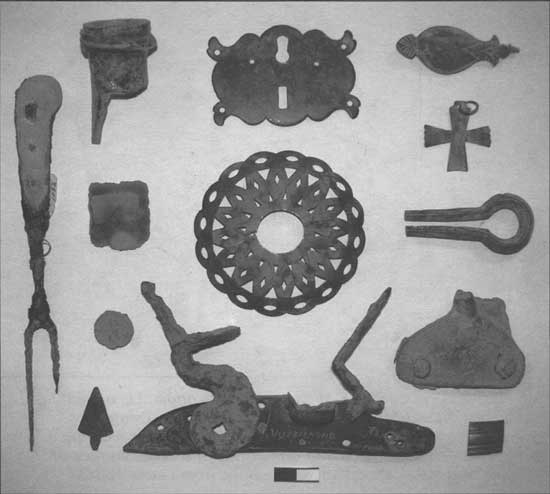
|
|
Figure 111: Historic period artifacts of silver, glass, iron, lead, etc.
including musket parts. The small, round piece is a lead seal for securing trunks
of cargo. The square piece on the left is a gun-flint made in France
that was shipped to the New World along with muskets and other weapons,
copper kettles and various trade goods between the 16th and 18th
centuries.
|
Archaeologists depend on artifact types to identify
the people they study. These types are distinguished by the recognition
of traditional designs and methods of manufacture that remain without
significant change over long periods of time. Since most of the
artifacts used by the Indians of the Historic period were made by Europeans, they do
not match the known prehistoric types that we are familiar with. Thus,
we have a prehistoric archaeological record based on knowledge of
traditional Indian artifacts that abruptly ends over only a few decades,
when they are overshadowed by artifacts of European manufacture. In
addition, these mass-produced items of European trade were made
available to many Indian groups over a very wide territory. In Indiana,
this dilemma has so far only fostered speculation about a few tribal
identities back into prehistory.
While we do not know why, apparently the Angel Mounds
village and most, or all, archaeological sites had long been abandoned
when the first explorers, traders and missionaries first came into
Indiana in the 17th century. Yet, a number of historic Native American
groups are repeatedly mentioned as having had settlements within
Indiana. The Miami and Potawatomi were apparently more numerous than
other groups, having had settlements spread over much of the state
(Figures 112-115). Yet, most scholars see language and cultural ties
to peoples living in Wisconsin and suggest the
Miami and Potawatomi probably migrated from the southwest side of Lake
Michigan beginning only as late as the 15th century. In fact, very
little prehistoric material culture appears to relate to them in Indiana
except perhaps in the northwestern part of the state. Caborn-Welborn
sites around the mouth of the Wabash are known to produce some European trade
goods, but no historical documents mention Native Americans in this
area.
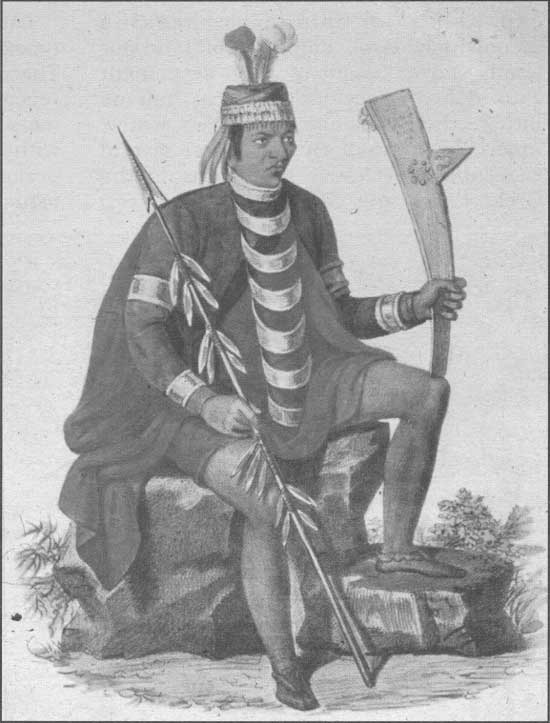
|
|
Figure 112: The Son, a Miami chief. The original is a
painting by James Otto Lewis that he completed at the Treaty of
Mississinewa, Indiana in 1827. The individual is wearing a series of
silver gorgets and arm bands and is holding a war club and metal tipped
spear (modified from Lewis 1836).
|

|
|
Figure 113: D-MOUCHE-KEE-KEE-AWH, a beautiful Potawatomi married to
Abram Burnett. "... No Pottawatomie squaw equaled her in regard
to dress; she was... plated with silver brooches—the very ne plus
ultra of an Indian woman's toilette" (modified from Ball 1948:
Plate XVIII).
|
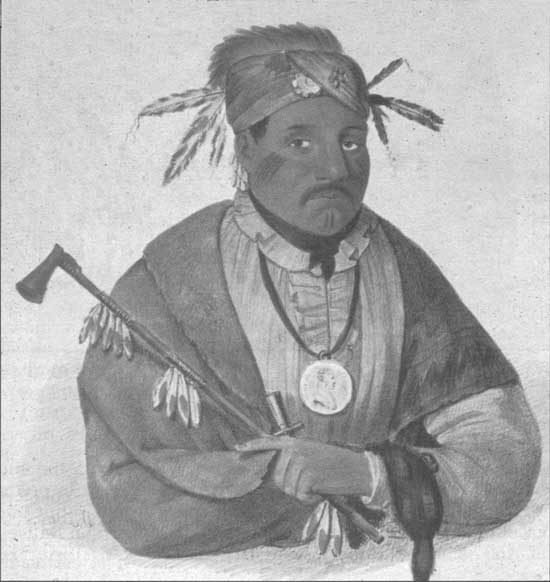
|
|
Figure 114: CHAT-O-NI-SEE, a Potawatomi chief. The individual has a
silver broach on his turban and is wearing a presidential medal around
his neck. The original is a painting by James Otto Lewis that he
completed at the Treaty of Fort Wayne in 1827 (modified from Lewis 1836).
|
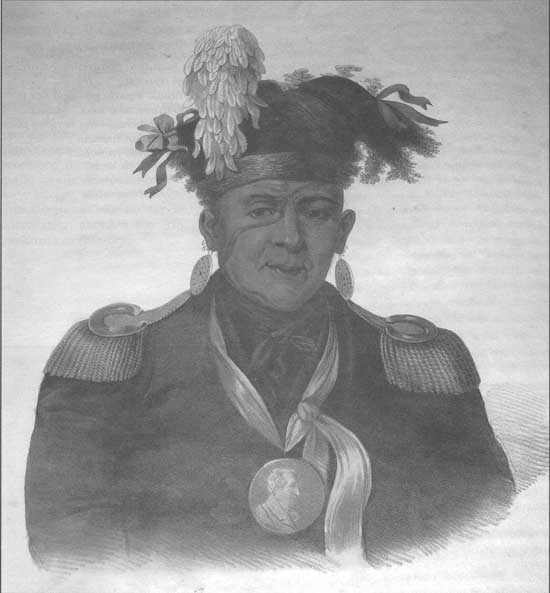
|
|
Figure 115: WA-BAUN-SEE, a Potawatomi chief
(modified from M'Kenney and Hall 1838:107).
|
Historic records also document Shawnee, Delaware, Piankashaw,
Kickapoo, and Wyandotte, as well as other groups that were in Indiana
only briefly before moving further west. Many scholars think at least
some of the villages attributed to the Fort Ancient tradition in
southern Ohio can be linked to the Shawnee. We are not so sure about
Oliver and Fort Ancient in Indiana, as the sites may represent
occupations by more than a single ethnic group. The Delaware and
Wyandotte were displaced from original homelands to the north and east
and settled, at least for a short time, between the White and Ohio
Rivers in southern Indiana (Figures 116-118).
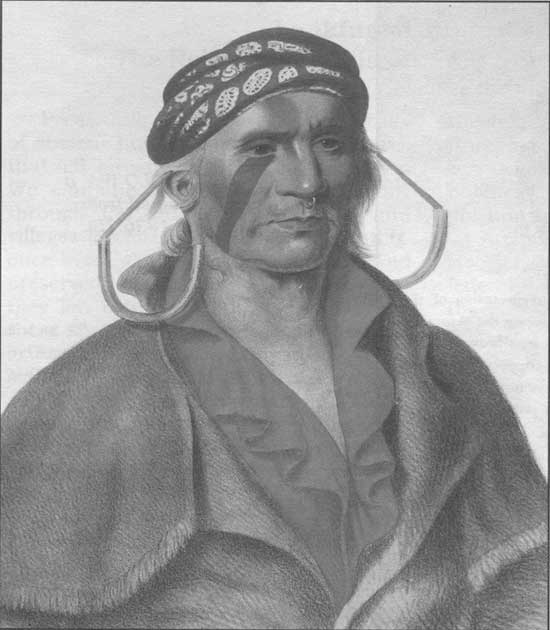
|
|
Figure 116: PAYTA KOOTHA or "Flying clouds", a Shawnee warrior
(modified from M'Kenney and Hall 1836:83).
|

|
|
Figure 117: KISH-KALLO-WA, a Shawnee chief (modified from
M'Kenney and Hall 1836:15).
|
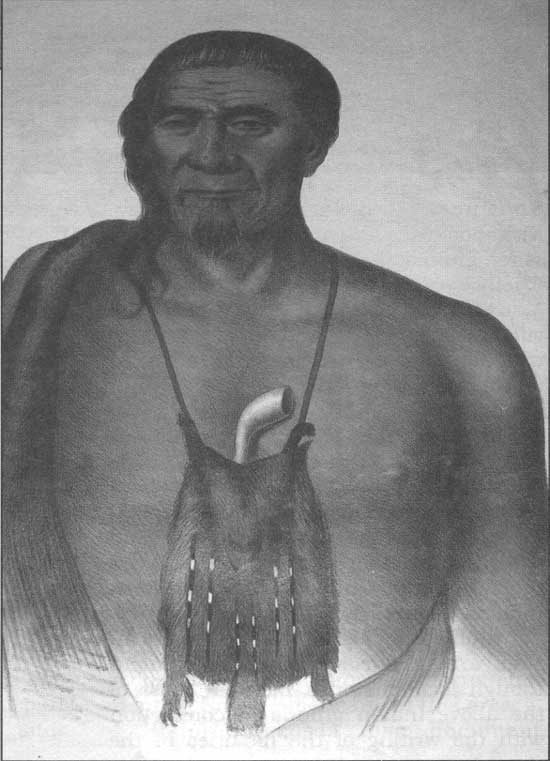
|
|
Figure 118: TISH-CO-HAN or "He who never blackens himself", a
Delaware chief (modified from M'Kenney and Hall 1836:199).
|
No historic period Native American sites are
archaeologically documented, though local histories mention most of the
above Indian groups in connection with the writing of the histories of
the nine county area encompassed by the Hoosier National
Forest. While little information provided on Native Americans in these
histories can be traced to original sources, we can assume that some
families related to these larger ethnic groups utilized either the hill
country for a short time or crossed through this area while slowly being
displaced westward by European settlement.
9/hoosier/prehistory/sec9.htm
Last Updated: 21-Nov-2008 |
|








